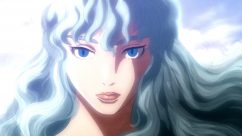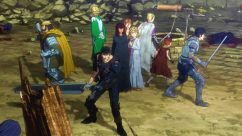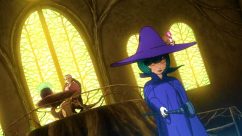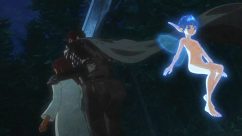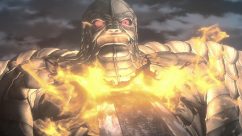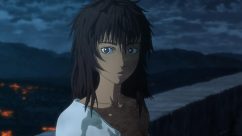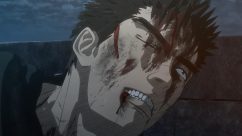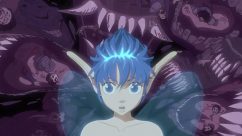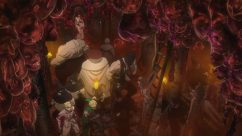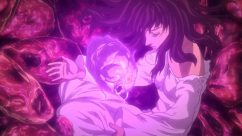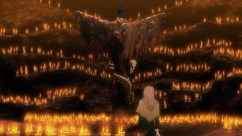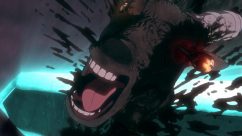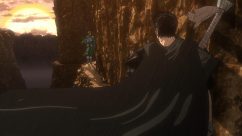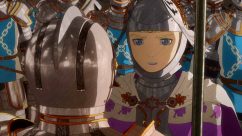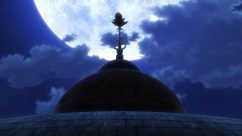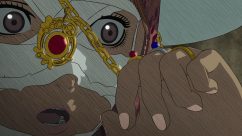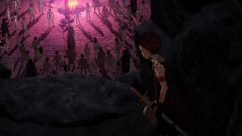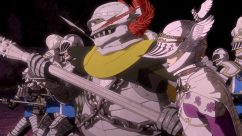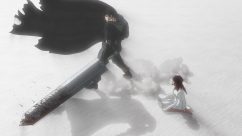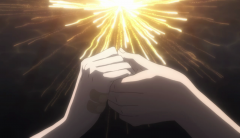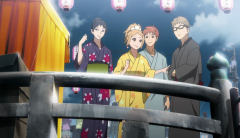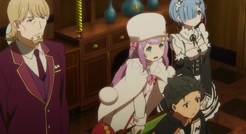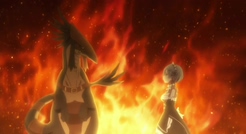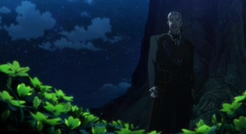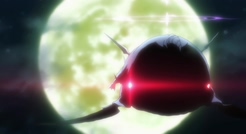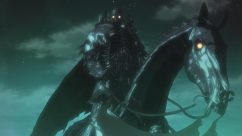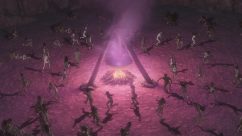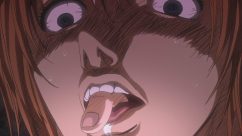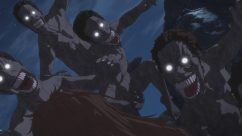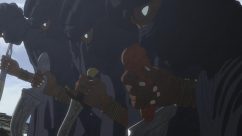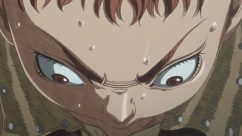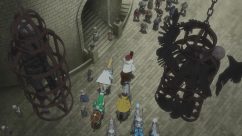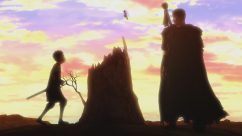I am truly sorry for the delay. I know I know … these excuses are becoming exceedingly homologous of a young student who has been procrastinating on his homework, but I give you my word, for at least what it’s worth, that this is certainly not the case. I have been preoccupied with my pet’s medical condition, and that has taken a toll on my time, wallet, and the ability to focus and attempt to give somewhat of a fair analysis. I thank all of you for your patience and support, and finally will attempt to dive right into the first cour finale, titled ‘Those Who Cling, Those Who Struggle’.
The episode picks up right where the last one left off, with our heroes torch in hand ready to brave the encroaching horror that is engulfing Albion. Down by the courtyard we get one of the last scenes of Luca comforting Nina and once again endangering herself to shelter her. Nina has the bulk of her growth in this very episode, which basically adds up to her accepting her weaknesses and choosing to follow her destiny; wherever that may lead her.
Now we head back over to Guts and company on the ramparts, attempting to ward off the encroaching phantasm. I took extra note of Isidro’s remark regarding the fact that if the miasma is powered by human suffering, then how come the whole world is not already engulfed by such a conglomerate? However, the fact of the matter is that Isidro is still unaware of the significance of the event unfolding at the tower at this particular night; which has rendered the boundary between the physical realm and the astral world especially uncapacious.
Farnese’s whimpering has also become rather grating by this point, but thankfully this will be the turning point for her. What is refreshing though is her newfound admiration for Guts. This follows a trend that has been steadily developing, but as I will explore in my season review this still doesn’t necessarily lead to her becoming a more compelling character in the future. I liked Guts’ remark about not wasting time on prayer, as she will need both of her hands for fighting. This is on the surface referring to the physical gesture of holding hands together during prayer, and also insinuating that any preoccupation with faith and prayer will only detract in a real battle.
At the top of the newly-formed Godhand tower the Egg of the New World is about to hatch. Puck remarks that the mass of souls are all screaming in unison. It is implied that the spirits are all pleading for some form of salvation to come and free them from their hellish existence. Griffith reborn as the Hawk of Light pierces the darkness, and seemingly offers respite to the damned souls; albeit the truth is far more sinister than what meets the eye. Upon the completion of the reincarnation ceremony the tower crumbles and all the ghastly tide retreats back towards the depths of the Vortex.
We get a brief introduction to Schierke, her master Flora, and the female elf Ivalera, as the percussions of the ceremony are felt throughout the land. This is a very significant event in the world of Berserk, and it can be argued that everything since the Eclipse has been leading up to this moment. The new series has also been emphasizing this, by creating a momentum through its pacing that has steadily marched towards this encounter. For such a long build-up and implied preeminence, this moment was handled rather poorly. Any gravity that is present here is mostly achieved through the viewer’s familiarity with the world and the characters, while the contributions of the actual show add up to bot all that much.
The gang’s reunion is interrupted by the appearance of Silat and his Bairaka clansmen. He uses the term “Krishna Sena” to refer to Gut’s party, which upon some research seems to roughly translate to ‘God’s Legion’. This might be a reference to the perceived supernatural circumstances that Silat has come to associate with each of his prior encounters with Guts. We get another action scene, which while short-lasting is still done more competently than some of the previous ones. We get Guts cutting through a whole squad with a single slash, as usual, while Serpico utilizes an interesting triple Remise to neutralize three opponents (this is a fencing move that is achieved by rapid thrusts without withdrawing the sword after each attack). Jerome, Isidro, and even Azan join in the fray, and for a moment we get a glimmer of the harmony that the original Band of the Hawk displayed during the Golden Age.
This continues until Zodd makes his re-entrance. They translated one of the soldier’s remarks regarding Zodd as “Bada”, which I can only assume is a stand-in for the word ‘beast’. Seeing Zodd can only mean one thing: that Griffith is not too far behind, and right on queue- here comes the bride! Guts is about to go full berserker, but seeing the distress in Casca reminds him once again of his priorities, signaling a growth in character that has taken him far past his Black Swordsman days. The Skull Knight also drops in to make this a proper family reunion.
The final section is dedicated to tying up some loose ends, and establishing Guts’ new fellowship. Luca is found to have survived by falling/hiding in a well. This serves as a clear parallel to the old lady who survived the atomic blast in Nagasaki by accidentally tripping into a well, as illustrated by Fred Weiner’s famous 1978 World War II documentary The Unknown War.
We proceed to set up each character’s objective, and this serves as a segue into the inevitable second cour. All in all, this finale was not as bad as I thought it’d be, but to be fair my expectations were very stunted by this point. The whole thing was true to the source material and quite serviceable, but also devoid of much real joy and excitement. Not all of this is the fault of this series however, and I will soon delve into all of that with much more detail in the upcoming season one review. I am already working on that, and aim to make it the most critical and literary analysis of the show as a whole. Thank you for your time and continuous patronage, and stay tuned for a comprehensive look at Berserk 2016.
~Bam~

